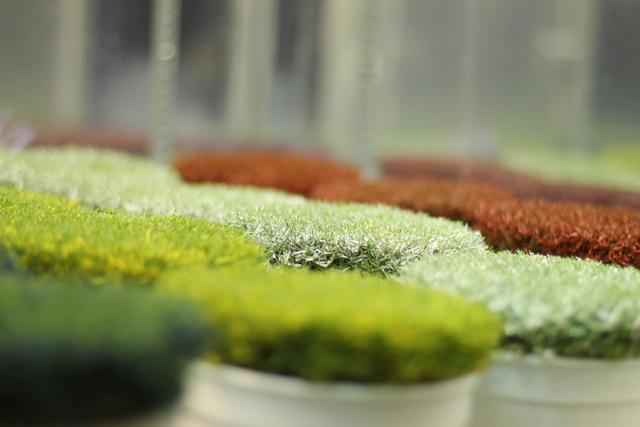
© NCSU Student Media 2012
Several samples of painted turfgrass receive optimal conditions for growth in growth chambers located in the Phytotron on Thursday, March 15, 2012. Results from the study on painted turfgrass have shown that the light absorbed by the pigments in the paint are not transfered to the plant, leading to a decrease in photosynthesis. Photo by Tyler Andrews
It’s no surprise that spraying paint chemicals on grass will have harmful consequences for the health of the turf. However, according to researchers at N.C. State, one of the largest impacts paint has on a plant isn’t in the chemicals – it’s all in the color.
Painting grass isn’t a big concern for most consumers, but for those in the sports world, the upkeep of turf is essential.
“Years ago, people didn’t care what the field looked like,” Grady Miller, professor of crop science, said. “They just went to see the game.”
Now, however, a poor field can reflect poorly upon the image of the team itself.
Miller said he wanted a graduate student to work on a turfgrass project for a long time; however, the prospects of working with turf aren’t as glamorous as other projects in the crop science field.
Reynolds’ project started out by trying to answer the very fundamental question of how paint affects turfgrass growth. While investigating, Reynolds observed that it wasn’t the chemicals used, but the colors used that had a large impact on the turf.
We’re taught in school that plants need the sun’s light to get nourishment from photosynthesis. Schools tend to leave out the fact that plants do not require the full spectrum of light to get their daily meals. According to Miller, plants only need two wavelengths of light for photosynthesis – red and blue.
Reynolds tested various colors used in ACC sports teams, and compared how they inhibited photosynthesis. The worst paint color in the ACC? Duke University, with a photosynthesis reduction of over 80 percent.
The simplest way to avoid the problem of killing grass would be to just change colors.
“But let’s be honest,” says Miller. “Colleges aren’t going to change their colors just to save grass.”
To tackle the problem of colors, Miller contacted Michael Paesler , a professor of physics with expertise in optics.
Paesler’s original intent was to find a way to make certain colors without involving the more harmful pigments. However, that part of the team’s research has been abandoned for several reasons. According to Paesler , one of the problems with that idea was that pigments aren’t very precise when it comes to colors. Pigments use a wide swath of colors to provide a specific shade. For example, the trademark Wolfpack-red paint contains many different shades and hues of red and other colors in order to provide the perfect appearance.
According to Paesler , the team also considered using nanotechnology to solve the problem. This may still be possible, but it would be impractical for use in commercial paint.
Now the team’s project is concerned with how paint affects turfgrass physically. In addition to absorbing sunlight, plants also need to ‘breathe’ in order to maintain their basic metabolic functions. Plants take in carbon dioxide and expel oxygen through tiny pores called stomata. Biophysicist Robert Riehn was recently brought in to help investigate how paint particles diffuse through a plant’s stomata, and to see if the paint impedes the plant’s respiration.
“We don’t really have microscopic knowledge about paint and plants, but we have some ideas about what goes on,” Riehn said.
Riehn and the other researchers plan to use N.C. State’s focused ion beam, which can cut very precise sections of material into cut cross-sections of these pores and examine where and in what quantity paint diffuses through a plant.
Riehn predicts three likely scenarios that depend on the size of the paint particles. If the particles are a bit larger than the size of the pores, the paint may be clogging the pores from the outside. If the particles are much larger than the stomata, they may be too large to cause any significant blockage. The third and most difficult scenario to deal with is that the paint particles are small enough to block the plant’s pores from the inside.
The ultimate goal of the experiment is to try and figure out another method for applying paint that could lessen the effects of stomata blockage. However, the research team is still waiting to earn funding for this latest endeavor, according to Miller.
“Schools like State and Duke will always kill grass,” Miller said.
But perhaps the upcoming tests will provide some way of reducing our impact.